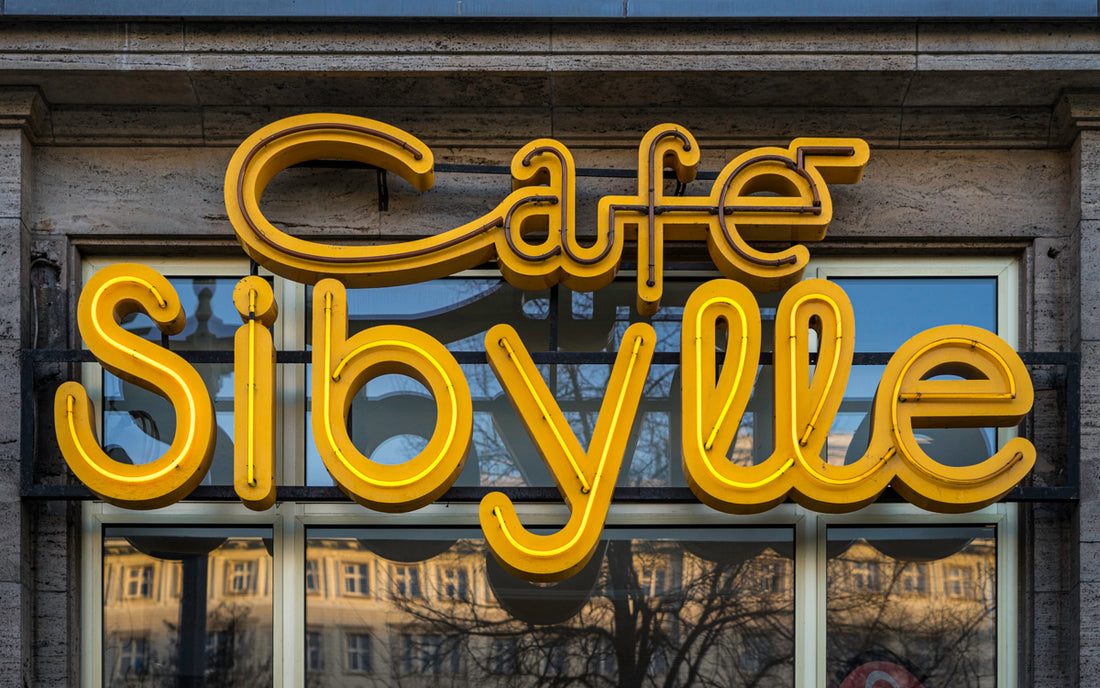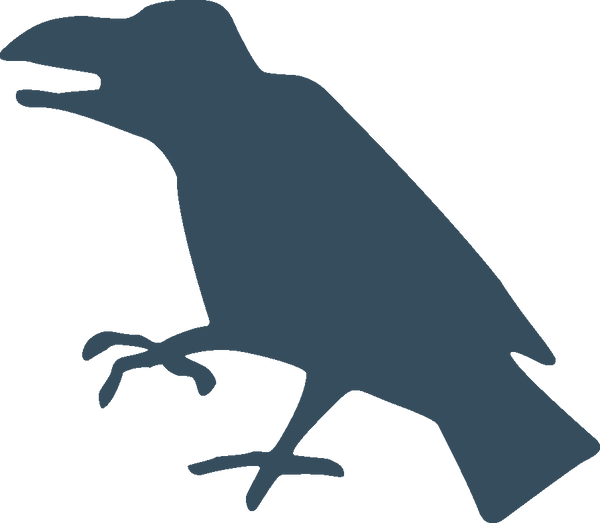
A walking tour of neon signs along Berlin’s Karl-Marx-Allee by Jesse Simon
Share
Although many neon signs disappeared from the streets of East Berlin shortly after the reunification of Germany in 1991, a high concentration of signs from the DDR era can still be found on the monumental buildings of Karl-Marx-Allee. Berlin-based writer Jesse Simon takes us on a walk down one of Berlin’s most fascinating avenues accompanied by our latest Berlin map: the Berlin Type Map.
Karl-Marx-Allee is worth visiting for its architecture alone: planned initially as
‘Stalinallee’, the avenue was conceived as a monumental thoroughfare lined with large residential blocks built in the ornate neo-classical style popular in the eastern bloc during early 1950s. While socialist classicism went out of fashion immediately after Stalin’s death in 1953, the second phase of the avenue – which was renamed for Karl Marx in 1961 – witnessed the first wave of the modular Plattenbauten that would come to define urbanism in East Germany.
The avenue, however, is equally fascinating for enthusiasts of urban typography. Because of the historical significance of the buildings, they were granted Denkmalschutz – the German equivalent of listed status – after reunification, and in some cases this protection extended to the neon signs attached to the façades. As a result, the section of Karl-Marx-Allee from Frankfurter Tor to Schillingstraße offers a rare, and easily-walkable, glimpse into the inspired artistry of commercial signage in the former East Berlin.

Kaffee und Tee
Our tour begins just outside Frankfurter Tor U-Bahn station (U5), the eastern end of the first phase of Karl-Marx-Allee. While the grand “workers’ palaces” that line the avenue were forced to adopt the state-sanctioned socialist-classical style, their integration of residential and commercial spaces within the same structure were in line with modernist trends in urbanism. Each block thus contained an assortment of shops and cafés, and the avenue quickly established a reputation as East Berlin’s premier commercial and cultural destination. Few of the original shops survived the economic changes that came as a result of reunification, but on the northeastern corner of Frankfurter Tor it is still possible to sit down for a warm beverage beneath the magnificent neon sign that promises ‘Kaffee und Tee’. Although the café is relatively recent, its seventies décor has been carefully assembled to convey an East Berlin vibe. As of a few years ago the sign still functioned.

Kosmos
Walking west along the North side of Karl-Marx-Allee we encounter the former
Filmtheater Kosmos, which was, along with the Kino International (see below), one of the two great cinemas of post-war East Berlin. Both were designed by Josef Kaiser and constructed in the first years of the 1960s; however, while the six-hundred-seat International is still used for its original purpose, the thousand-seat Kosmos was transformed into an event space in the early 2000s. The current sign on the tiled façade of the building is a new – and not entirely faithful – recreation of the original: but if the older sign featured visible neon tubes, wider spacing between the letters and no underline, the recently-installed geometric sans nonetheless preserves the post-war-modernist flavour of the earlier version.
Fleischwaren
The peeling red paint and the word ‘Fleischwaren’ in extended cursive leave us in no doubt that there was once a butcher shop beneath this sign. For the last few years the shop contained an imbiss, or snack bar, specialising in meat products; however the imbiss recently closed, leaving the future of the space in doubt. Although the sign is nominally protected, Berlin does not have the best track record when it comes to the observance of Denkmalschutz, so we can only hope that another butcher shop – or, more probably, a high-end meat-focussed restaurant – moves in to fill the void.

Briefmarken
Just as the Fleischwaren sign (above) no longer corresponds to a butcher’s shop, the philatelist beneath the neon Briefmarken sign on the north side of the street has long since disappeared. Although the current tenants are in the business of selling wine rather than stamps, they made the sensible decision not to let a perfectly good neon sign go to waste and named their shop ‘Briefmarken Weine’. While most of the green neon still works at night, the last two letters of the sign have been burnt out for a few years, reducing the plural to a mere singular.

Blumen / Five Years
A few yards south of Karl-Marx-Allee on Straße der Pariser Kommune we come across one of Berlin’s finest flower-shop signs. The cursive letterforms were designed by Manfred Gensicke, a graphic and commercial artist based in East Berlin who was also responsible for the ‘Zierfische’ neon sign that once stood at Frankfurter Tor (and is now in the collection of Berlin’s Buchstabenmuseum). The swoosh above the u is not an Umlaut, but rather a convention borrowed from German cursive handwriting, in which the lower-case n and u were often indistinguishable. Although the two letters have their own distinct identity in this sign, the swoosh can still be spotted in flower-shops throughout Berlin.
It is easy to be awed by the beauty of the Blumen sign, but it is worth having a quick look at the gate to the passage immediately to the left of the flower shop, which commemorates the first five years of the avenue in its ironwork.

Karl-Marx-Buchhandlung
The Karl Marx bookshop opened in the Richard-Paulick-designed Block C South in
1953 – almost immediately after the building was completed – and was named for Marx even before the avenue had changed its name from Stalinallee. It played a crucial role in the intellectual life of East Berlin and even managed to survive into the era of reunification; it could not, however, survive the rise of internet commerce – which spelled the end for so many bookshops in the first decade of the new century – and was eventually forced to close in 2008. Although the space has been put to several different uses in the years since – some literary, some not – the extraordinary sign has been preserved as a reminder of its illustrious past.

Café Sibylle / Lichthaus
The original café at the Western corner of Block C South was apparently named for the popular East German women’s fashion magazine Sibylle and was, itself, a fashionable spot in its day. The present-day café is a more low-key neighbourhood hang out, but it has retained both the original name and the gloriously idiosyncratic neon sign (the lower part of which still worked as of two years ago). Before going in for coffee and cake – and a look at their collection of DDR-era photos and memorabilia – be sure to appreciate the curious acute accent extending from the side of the e and the mixture of standalone and cursive letters in the word ‘Sibylle’.
If you’re not yet ready to stop for a coffee, you can cross to the north side of the street where a neon sign for a no-longer-extant lighting showroom is still attached to the Western corner of Block C North.
Non-neon Interlude
Not long after Café Sibylle we pass through Strausberger Platz, a traffic circle with a modernist fountain in the centre and flanked on the Western side with two towers. These impressive structures, designed by Hermann Henselmann – an avowed modernist who was nonetheless forced to work in the state-approved architectural style of the time – mark one end of the first phase of Karl-Marx-Allee, and each tower features an inscription on its Western face. The northern tower includes part of a poem by Bertholt Brecht, while the southern offers a couplet from part two of Goethe’s Faust. Both inscriptions are worth seeking out for the inventiveness of their Umlauts, which are, for the most part, inset into the letterforms.
By the time these towers were completed, the second phase of Karl-Marx-Allee – from Strausberger Platz to Alexanderplatz – was already underway, and in this newer section we find the ornate structures of the first phase replaced with Plattenbauten, modular residential blocks constructed from precast concrete panels. The integration of residential and commercial functions within a single structure had also disappeared, and most of the shops and restaurants were constructed as standalone buildings.

Tatra / Balkancarpodem
Modern Berlin is not given to rooftop advertisements: the Coca Cola sign at the end of Leipziger Straße or the Bosch sign on Bismarckstraße are rare exceptions to the rule. But this was not always the case, and East Berlin embraced rooftop advertising with as much zeal as the West. Most have disappeared: the strange skeletal constructions atop Henselmann’s towers at Strausberger Platz offer faint traces of where the neon signs would once have stood. However if we walk a few yards west, we come to a pair of Plattenbauten, facing one another across the street, that still feature the real thing. On the southern building is a large sign for Balkancarpodem, a Bulgarian company specialising in hoists and cranes; the sign apparently dates from the early 1960s, almost immediately after the building was completed. On the north is a sign for Tatra Motokov, a Czech car and truck manufacturer. Both companies, incidentally, still exist; and a visit to the Tatra website reveals that their logo has remained largely unchanged in the half century since the sign was first put in place.

Café Moskau / Kino International
Our tour comes to an end at the entrance to Schillingstraße U-Bahn where we are greeted by a cluster of intriguing signs. On the South side of the street is the Café Moskau which is pressed into service occasionally as an event space and conference venue, but has been mostly empty for the last several years. During the DDR era, however, it was a hot-spot for dining and dancing, and was one of a number of Cafés along Karl-Marx-Allee named for capitals of eastern bloc states (there were also Cafés named for Prague, Warsaw and Budapest). Don’t miss the replica of the Sputnik satellite on the corner of the building above the neon signs; nor should you ignore the large mosaic celebrating the peoples of the (former) Soviet Union. The building on the other side of Schillingstraße – which serves, in part, as one of the entrances to the U-Bahn station – was once a florist, but is now a shop devoted to camping supplies; in recent years they replaced their original sign with a new series of neon signs that match those of the Café Moskau. On the north side of Karl-Marx-Allee stands the Kino International, still one of Berlin’s best cinemas and arguably one of the finest works of post-war Modernism to emerge from the DDR. Designed by Josef Kaiser – who also designed the Café Moskau – and completed in 1962, the International is now part of the Yorck Kinogruppe, a local chain specialising in independent cinema, and serves as a venue in the city’s annual film festival. The large street-facing neon sign was looking worn and weather-damaged a few years ago, but was restored to its original glory in time for its 60th anniversary.

